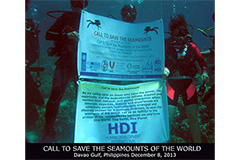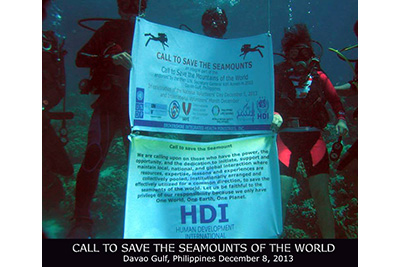Davao Gulf Seamounts Need Saving
|
Photo: John Ryan Largo
|
Sunday, 8th December, 2013, a group of environmentally motivated scuba divers, from Davao City, launched a call to save the seamounts of the Davao Gulf from rape and destruction by unsustainable fishing methods. Worthy though the call to save the seamounts is, one wonders whether a more sustainable approach to the promotion may generate wider support.
What are seamounts? A seamount is a mountain under the sea, typically remote from other subterranean geological formations; found throughout the world’s oceans, sometimes hundreds of miles from land. The only thing that stops seamounts being islands is the fact that their flat tops remain permanently beneath the waves. A seamount offers a uniquely secluded environment for marine life, where evolution may create distinct species of marine organisms. Seamounts almost always provide a feeding station for otherwise pelagic fish.
If you had the chance to read Peter Benchley’s novel ‘The Girl Of The Sea Of Cortez’ (1982) then you would have a fair understanding of the importance placed on seamounts by both fishermen and supporters of environmental conservation. You will also understand why Man’s ever increasing need to extract fish protein from the sea encourages fishermen to view seamounts as places to obtain a quick profit rather than as places to be conserved for long term, sustainable benefit.
Fly any airline route over the archipelago of the Philippines (see link at bottom of page) and you will see the occasional pale blue spot beneath the cobalt waves, where a coral reef has grown on top of a seamount.
A good example of an over-fished seamount in the Philippines can be found about half way between Coron Island (Palawan) and Cape Calavite (on the northwest tip of Mindoro Island). A decade ago you would find scores of fishing boats over the seamount, day and night. Today there only a few fishing boats there because the daily profit is too small for so many to travel so far from port.
Turning to the materials used for displaying the Davao scuba divers’ “Save The Seamounts” message: a tarpaulin made primarily from polyethylene (PE).
Polyethylene is manufactured from petroleum products and is not biodegradable, i.e. is not sustainable. The use-once & throw away tarpaulin material used for such promotions has become ubiquitous in many parts of the world, because it is waterproof at the outset and can be printed inexpensively and quickly, using modern digital printers. The problem is that ultraviolet (UV) degrades the material quite quickly (in a matter of months) and once degraded the petroleum byproducts enter the refuse chain, most frequently via the nearest landfill site.
There once was a time, not so long ago (before large format digital printers), where promotional banners and streamers were made from cotton sheets, painted by hand by skilled sign-writers, i.e. using almost completely sustainable and biodegradable materials. Would this not have been a better material to be used by the Davao scuba divers to demonstrate the sustainable approach to marine conservation? One may suspect that the paint would dissolve in the water but if the correct choice of paint was used then it would have lasted long enough to get the message across to the camera.
Instead, a tarpaulin, useless for anything else (because it is not large enough to be reused to offer shelter to a family in Samar or Leyte), has been made using PE, for a one time use and with an end result that petroleum products will soon be leaching into the ground water from a Davao landfill.
Now take another look at the photograph . . . are the divers swimming or displaying neutral buoyancy? No. In fact they are standing on the seamount that they are proposing to protect. Every scuba diving instructor I have ever met will tell you that standing on the seafloor (unless there is only a large expanse of sand) is a no-no because, no matter how careful you are, you will always damage some of the coral.
That the save the seamounts event was apparently supported by Human Development International, UN Environmental Program and a number of other NGOs, plus private enterprises, is rather strange. These supporting entities must surely be unaware of the methods used for promoting; else they would equally surely not have allowed their names to be directly connected . . . unless of course the error here is the communications officer or the campaign specialist.
When promoting any advocacy that is potentially controversial it is essential that statements and images that can detract or misdirect be avoided. Whenever there is controversy there will be detractors who will take every opportunity to diminish the credibility of the promoter and / or the objectives of the advocacy . . . providing detractors with ready-to-use ammunition is not the smartest thing to do.
Please think, and think sustainably; we only have one Philippines to bequeath to our grandchildren.
Find Philippine airlines’ routes to discover seamounts for yourself



 Scuba Divers want to save Davao Gulf seamounts
Scuba Divers want to save Davao Gulf seamounts